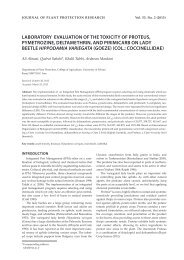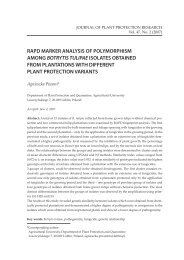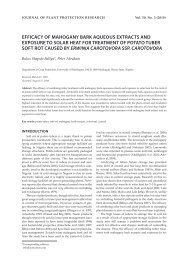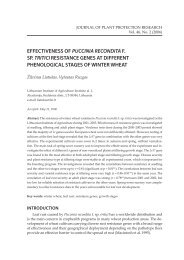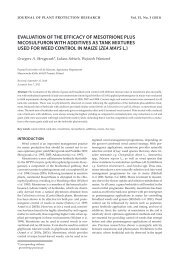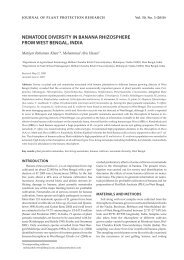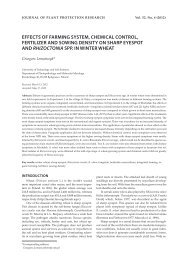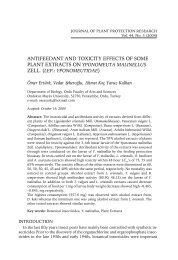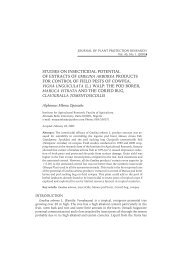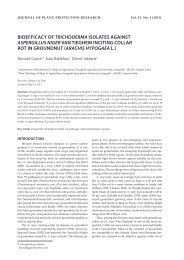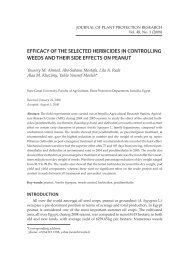effect of trichoderma isolates on yielding of wild strains of coprinus ...
effect of trichoderma isolates on yielding of wild strains of coprinus ...
effect of trichoderma isolates on yielding of wild strains of coprinus ...
Create successful ePaper yourself
Turn your PDF publications into a flip-book with our unique Google optimized e-Paper software.
JOURNAL OF PLANT PROTECTION RESEARCH Vol. 51, No. 4 (2011)<br />
EFFECT OF TRICHODERMA ISOLATES ON YIELDING<br />
OF WILD STRAINS OF COPRINUS COMATUS<br />
Dorota Frużyńska-Jóźwiak 1 *, Krzyszt<str<strong>on</strong>g>of</str<strong>on</strong>g> Sobieralski 2 , Marek Siwulski 2 ,<br />
Tomasz Spiżewski 2 , Lidia Błaszczyk 3 , Iw<strong>on</strong>a Sas-Golak 2<br />
Poznań University <str<strong>on</strong>g>of</str<strong>on</strong>g> Life Sciences<br />
Dąbrowskiego 159, 60-594 Poznań, Poland<br />
1<br />
Department <str<strong>on</strong>g>of</str<strong>on</strong>g> Phytopathology<br />
2<br />
Department <str<strong>on</strong>g>of</str<strong>on</strong>g> Vegetable Crops<br />
3<br />
Institute <str<strong>on</strong>g>of</str<strong>on</strong>g> Plant Genetics, Polish Academy <str<strong>on</strong>g>of</str<strong>on</strong>g> Science<br />
Strzeszyńska 34, 60-479 Poznań, Poland<br />
Received: March 3, 2011<br />
Accepted: July 18, 2011<br />
Abstract. The impact <str<strong>on</strong>g>of</str<strong>on</strong>g> infestati<strong>on</strong> with Trichoderma aggressivum f. europeanum and Trichoderma l<strong>on</strong>gibrachiatum <str<strong>on</strong>g>isolates</str<strong>on</strong>g> <strong>on</strong> the <strong>yielding</strong><br />
<str<strong>on</strong>g>of</str<strong>on</strong>g> three <strong>wild</strong> <strong>strains</strong> and <strong>on</strong>e cultivated strain <str<strong>on</strong>g>of</str<strong>on</strong>g> Coprinus comatus was investigated. A significant yield reducti<strong>on</strong> <str<strong>on</strong>g>of</str<strong>on</strong>g> C. comatus <strong>on</strong><br />
substrates infested with the examined Trichoderma <str<strong>on</strong>g>isolates</str<strong>on</strong>g> was determined. The recorded percentage yield reducti<strong>on</strong> was significantly<br />
higher in the case <str<strong>on</strong>g>of</str<strong>on</strong>g> the infestati<strong>on</strong> with the T. aggressivum than with the T. l<strong>on</strong>gibrachiatum isolate.<br />
Key words: Trichoderma spp., Coprinus comatus, <strong>wild</strong> <strong>strains</strong>, cultivated strain, yield<br />
INTRODUCTION<br />
The greatest losses in mushroom cultivati<strong>on</strong> are<br />
brought about by fungi from the Trichoderma genus which<br />
cause green moulds (Mamoun et al. 2000). The most aggressive<br />
forms <str<strong>on</strong>g>of</str<strong>on</strong>g> the above-menti<strong>on</strong>ed fungi were designated<br />
as Trichoderma aggressivum f. europeanum Th2 in<br />
Europe, and T. aggressivum f. aggressivum strain Th4 identified<br />
in North America (Williams et al., 2003). The abovementi<strong>on</strong>ed<br />
<strong>strains</strong> c<strong>on</strong>stitute biotypes <str<strong>on</strong>g>of</str<strong>on</strong>g> a n<strong>on</strong>-aggressive<br />
form <str<strong>on</strong>g>of</str<strong>on</strong>g> T. harzianum in relati<strong>on</strong> to cultivated mushrooms.<br />
The aggressive <strong>strains</strong> differ from n<strong>on</strong>-aggressive forms,<br />
primarily, by the speed <str<strong>on</strong>g>of</str<strong>on</strong>g> mycelium growth (Samuels<br />
et al. 2002; Sobieralski et al. 2009). The cultivati<strong>on</strong> <str<strong>on</strong>g>of</str<strong>on</strong>g> Agaricus<br />
bisporus is technologically similar to the cultivati<strong>on</strong> <str<strong>on</strong>g>of</str<strong>on</strong>g><br />
Coprinus comatus. In the cultivati<strong>on</strong> <str<strong>on</strong>g>of</str<strong>on</strong>g> A. bisporus, apart<br />
from the above-menti<strong>on</strong>ed species <str<strong>on</strong>g>of</str<strong>on</strong>g> Trichoderma, the species<br />
T. atroviride and T. l<strong>on</strong>gibrachiatum also frequently occur<br />
(Szczech et al. 2008).<br />
The objective <str<strong>on</strong>g>of</str<strong>on</strong>g> the performed investigati<strong>on</strong>s was to<br />
determine the influence <str<strong>on</strong>g>of</str<strong>on</strong>g> the substrate infestati<strong>on</strong> with<br />
T. aggressivum f. europeanum and T. l<strong>on</strong>gibrachiatum <str<strong>on</strong>g>isolates</str<strong>on</strong>g>,<br />
<strong>on</strong> <strong>yielding</strong> <str<strong>on</strong>g>of</str<strong>on</strong>g> several <strong>wild</strong> <strong>strains</strong> and <strong>on</strong>e cultivated<br />
strain <str<strong>on</strong>g>of</str<strong>on</strong>g> C. comatus.<br />
MATERIALS AND METHODS<br />
Both <str<strong>on</strong>g>isolates</str<strong>on</strong>g> <str<strong>on</strong>g>of</str<strong>on</strong>g> Trichoderma as well as C. comatus <strong>strains</strong><br />
derived from the collecti<strong>on</strong> <str<strong>on</strong>g>of</str<strong>on</strong>g> cultivated mushrooms <str<strong>on</strong>g>of</str<strong>on</strong>g><br />
the Department <str<strong>on</strong>g>of</str<strong>on</strong>g> Vegetable Crops, Poznań University<br />
<str<strong>on</strong>g>of</str<strong>on</strong>g> Life Sciences. Two Trichoderma <str<strong>on</strong>g>isolates</str<strong>on</strong>g> i.e. T. aggessivum<br />
f. europaeum T.a/c/KW/11/12 and T. l<strong>on</strong>gibrachiatum T.l/d/<br />
KW/3/27 obtained from mushroom farms, were used in<br />
the experiment. Identificati<strong>on</strong> <str<strong>on</strong>g>of</str<strong>on</strong>g> <str<strong>on</strong>g>isolates</str<strong>on</strong>g> was carried out<br />
at the Institute <str<strong>on</strong>g>of</str<strong>on</strong>g> Plant Genetics – the Poznań Branch <str<strong>on</strong>g>of</str<strong>on</strong>g><br />
the Polish Academy <str<strong>on</strong>g>of</str<strong>on</strong>g> Sciences. The applied polimeraze<br />
chain reacti<strong>on</strong> (PCR) techniques, PCR multiplex and<br />
radom amplificati<strong>on</strong> <str<strong>on</strong>g>of</str<strong>on</strong>g> polymorphic DNA (RAPD) revealed<br />
that the <str<strong>on</strong>g>isolates</str<strong>on</strong>g> used in the experiments bel<strong>on</strong>ged<br />
to the T. aggressivum f. europeanum and T. l<strong>on</strong>gibrachiatum<br />
biotypes. Three <strong>strains</strong> <str<strong>on</strong>g>of</str<strong>on</strong>g> C. comatus: Cop.KW/12/2, Cop.<br />
RM/9/6 and Cop.WS/12/8 obtained in 2009 from natural<br />
sites located in different regi<strong>on</strong>s <str<strong>on</strong>g>of</str<strong>on</strong>g> Poland as well as <strong>on</strong>e<br />
cultivated strain Somycel 4030 were used in the experiments.<br />
Detailed methods and techniques <str<strong>on</strong>g>of</str<strong>on</strong>g> substrate and<br />
cover preparati<strong>on</strong> al<strong>on</strong>g with c<strong>on</strong>diti<strong>on</strong>s required during<br />
cultivati<strong>on</strong> were given by Siwulski et al. (2001).<br />
The results <str<strong>on</strong>g>of</str<strong>on</strong>g> the experiment were compared using<br />
the analysis <str<strong>on</strong>g>of</str<strong>on</strong>g> variance for factorial experiments at the<br />
level <str<strong>on</strong>g>of</str<strong>on</strong>g> significance α = 0.05 (the Newman-Keuls test).<br />
RESULTS<br />
The performed experiments revealed that the infestati<strong>on</strong><br />
<str<strong>on</strong>g>of</str<strong>on</strong>g> the cultivati<strong>on</strong> substrate with the T. aggressivum<br />
f. europaeum isolate resulted in a significant yield drop. The<br />
yields from the C. comatus <strong>strains</strong> obtained <strong>on</strong> the infested<br />
*Corresp<strong>on</strong>ding address:<br />
romstand@up.poznan.pl
Effect <str<strong>on</strong>g>of</str<strong>on</strong>g> Trichoderma <str<strong>on</strong>g>isolates</str<strong>on</strong>g> <strong>on</strong> <strong>yielding</strong> <str<strong>on</strong>g>of</str<strong>on</strong>g> <strong>wild</strong> <strong>strains</strong> <str<strong>on</strong>g>of</str<strong>on</strong>g> Coprinus comatu 411<br />
substrate, fluctuated from 18 to 37 g/kg fresh matter <str<strong>on</strong>g>of</str<strong>on</strong>g> substrate<br />
(Fig. 1). Yield reducti<strong>on</strong> varied widely from 26 to 59%<br />
(Table 1). Yields <str<strong>on</strong>g>of</str<strong>on</strong>g> the <strong>wild</strong> <strong>strains</strong> Cop.KW/12/2 and Cop.<br />
WS/12/8 as well as <str<strong>on</strong>g>of</str<strong>on</strong>g> the cultivated strain Somycel 4030<br />
grown <strong>on</strong> the substrate infested with the above-menti<strong>on</strong>ed<br />
isolate were reduced by similar values, namely: 56.1 and<br />
59.0%. The resp<strong>on</strong>se <str<strong>on</strong>g>of</str<strong>on</strong>g> the third <strong>wild</strong> strain – Cop.RM/9/6<br />
was different and the yield drop amounted to <strong>on</strong>ly 26%.<br />
Table 1. Reducti<strong>on</strong> <str<strong>on</strong>g>of</str<strong>on</strong>g> yield (in %) <str<strong>on</strong>g>of</str<strong>on</strong>g> <strong>wild</strong> and cultivated <strong>strains</strong><br />
<str<strong>on</strong>g>of</str<strong>on</strong>g> C. comatus grown <strong>on</strong> substrates infested with the<br />
T. aggressivum f. europaeum T.a/c/KW/11/12 isolate<br />
Strain + isolate<br />
Cop.KW/12/2 + T. aggressivum f. europaeum<br />
T.a/c/KW/11/12<br />
Cop.RM/9/6 + T. aggressivum f. europaeum<br />
T.a/c/KW/11/12<br />
Cop.WS/12/8 + T. aggressivum f. europaeum<br />
T.a/c/KW/11/12<br />
Som.4030 + T. aggressivum f. europaeum<br />
T.a/c/KW/11/12<br />
Yield reducti<strong>on</strong><br />
in %<br />
58.1<br />
26.0<br />
56.1<br />
59.0<br />
Analysing the <strong>yielding</strong> <str<strong>on</strong>g>of</str<strong>on</strong>g> C. comatus <strong>strains</strong> <strong>on</strong> substrates<br />
infested with the T. l<strong>on</strong>gibrachiatum isolate, showed<br />
a yield range <str<strong>on</strong>g>of</str<strong>on</strong>g> from 21 g/kg fresh matter <str<strong>on</strong>g>of</str<strong>on</strong>g> the substrate<br />
in the case <str<strong>on</strong>g>of</str<strong>on</strong>g> strain Cop.RM/9/6 to 65 g/kg fresh matter<br />
<str<strong>on</strong>g>of</str<strong>on</strong>g> the substrate in the case <str<strong>on</strong>g>of</str<strong>on</strong>g> the cultivated Somycel 4030<br />
strain (Fig. 2). Both <strong>wild</strong> <strong>strains</strong> and the cultivated strain<br />
<str<strong>on</strong>g>of</str<strong>on</strong>g> C. comatus grown <strong>on</strong> substrates infested with T. l<strong>on</strong>gibrachiatum<br />
isolate resp<strong>on</strong>ded with significant yield drops<br />
which, in the case <str<strong>on</strong>g>of</str<strong>on</strong>g> Cop.KW/12/2, Cop.WS/12/8 as well as<br />
Somycel 4030 <strong>strains</strong>, ranged from 21.9 to 30.7%. Yields <str<strong>on</strong>g>of</str<strong>on</strong>g><br />
the Cop.RM/9/6 strain were c<strong>on</strong>siderably lower and the recorded<br />
percentage yield drop amounted to 63.8% (Table 2).<br />
Table 2. Reducti<strong>on</strong> <str<strong>on</strong>g>of</str<strong>on</strong>g> yield (in %) <str<strong>on</strong>g>of</str<strong>on</strong>g> <strong>wild</strong> and cultivated <strong>strains</strong><br />
<str<strong>on</strong>g>of</str<strong>on</strong>g> C. comatus grown <strong>on</strong> substrates infested with the<br />
T. l<strong>on</strong>gibrachiatum T.l/d/KW/3/27 isolate<br />
Strain + isolate<br />
Cop.KW/12/2 + T. l<strong>on</strong>gibrachiatum<br />
T.l/d/KW/3/27<br />
Cop.RM/9/6 + T. l<strong>on</strong>gibrachiatum<br />
T.l/d/KW/3/27<br />
Cop.WS/12/8 + T. l<strong>on</strong>gibrachiatum<br />
T.l/d/KW/3/27<br />
Som.4030 + T. l<strong>on</strong>gibrachiatum<br />
T.l/d/KW/3/27<br />
Yield reducti<strong>on</strong><br />
in %<br />
30.7<br />
63.8<br />
21.9<br />
27.8<br />
Means followed by the same letter do not differ significantly according to Newman-Keuls’s test at p = 0.05<br />
Fig. 1. Yielding <str<strong>on</strong>g>of</str<strong>on</strong>g> <strong>wild</strong> and cultivated <strong>strains</strong> <str<strong>on</strong>g>of</str<strong>on</strong>g> C. comatus grown <strong>on</strong> substrates infested with the T. aggressivum f. europaeum<br />
T.a/c/KW/11/12 isolate<br />
Means followed by the same letter do not differ significantly according to Newman-Keuls’s test at p = 0.05<br />
Fig. 2. Yielding <str<strong>on</strong>g>of</str<strong>on</strong>g> <strong>wild</strong> and cultivated <strong>strains</strong> <str<strong>on</strong>g>of</str<strong>on</strong>g> C. comatus grown <strong>on</strong> substrates infested with the T. l<strong>on</strong>gibrachiatum T.l/d/KW/3/27<br />
isolate
412 Journal <str<strong>on</strong>g>of</str<strong>on</strong>g> Plant Protecti<strong>on</strong> Research 51 (4), 2011<br />
DISCUSSION<br />
Cultivati<strong>on</strong> facilities in which mushrooms are cultivated<br />
are characterised by relatively high temperatures<br />
and air humidity in additi<strong>on</strong> to large quantities <str<strong>on</strong>g>of</str<strong>on</strong>g> organic<br />
matter favouring the development <str<strong>on</strong>g>of</str<strong>on</strong>g> various species and<br />
forms <str<strong>on</strong>g>of</str<strong>on</strong>g> Trichoderma (Grogan 2005). Results obtained in<br />
the discussed experiments corroborate informati<strong>on</strong> presented<br />
in a number <str<strong>on</strong>g>of</str<strong>on</strong>g> earlier investigati<strong>on</strong>s carried out<br />
both in Poland and abroad, regarding the impact <str<strong>on</strong>g>of</str<strong>on</strong>g> fungi<br />
<str<strong>on</strong>g>of</str<strong>on</strong>g> the Trichoderma spp. <strong>on</strong> yields <str<strong>on</strong>g>of</str<strong>on</strong>g> the comm<strong>on</strong> mushroom<br />
mycelium. Researchers dem<strong>on</strong>strated, a c<strong>on</strong>siderable<br />
decline <str<strong>on</strong>g>of</str<strong>on</strong>g> yields <str<strong>on</strong>g>of</str<strong>on</strong>g> A. bitorquis in the case <str<strong>on</strong>g>of</str<strong>on</strong>g> its<br />
infestati<strong>on</strong> with the T. aggressivum f. europaeum isolate (Sobieralski<br />
et al. 2010a). Moreover, they also dem<strong>on</strong>strated<br />
that the resp<strong>on</strong>se <str<strong>on</strong>g>of</str<strong>on</strong>g> the comm<strong>on</strong> mushroom <strong>strains</strong>, gathered<br />
from natural sites, to substrate infestati<strong>on</strong> with the<br />
examined T. aggressivum f. europaeum <str<strong>on</strong>g>isolates</str<strong>on</strong>g>, varied significantly.<br />
The observed yield drops ranged from 23.1 to<br />
84%. The researchers also further dem<strong>on</strong>strated c<strong>on</strong>siderable<br />
yield reducti<strong>on</strong>s in other mushroom species, am<strong>on</strong>g<br />
others: A. bisporus (Sobieralski et al. 2009), P. ostreatus (Siwulski<br />
et al. 2009) and P. eryngii (Sobieralski et al. 2010b).<br />
Recent investigati<strong>on</strong>s carried out by Frużyńska-Jóźwiak<br />
et al. (2010) revealed that C. comatus <strong>strains</strong> can exhibit<br />
certain defense mechanisms in relati<strong>on</strong> to T. aggressivum<br />
and T. l<strong>on</strong>gibrachiatum <str<strong>on</strong>g>isolates</str<strong>on</strong>g>. It was found in the above<br />
experiments that growth inhibiti<strong>on</strong> <str<strong>on</strong>g>of</str<strong>on</strong>g> the C. comatus mycelium<br />
by the T. l<strong>on</strong>gibrachiatum and T. atroviride species<br />
was much smaller than by T. aggressivum.<br />
In the performed experiments the recorded declined<br />
<str<strong>on</strong>g>of</str<strong>on</strong>g> the C. comatus yield was c<strong>on</strong>siderably higher in the<br />
case <str<strong>on</strong>g>of</str<strong>on</strong>g> the infestati<strong>on</strong> with T. aggressivum than with the<br />
T. l<strong>on</strong>gibrachiatum isolate. Moreover, the obtained results<br />
showed that the resp<strong>on</strong>se <str<strong>on</strong>g>of</str<strong>on</strong>g> the examined <strong>strains</strong> expressed<br />
by the percentage drop in yields could be specific<br />
for individual <strong>strains</strong>. An interesting observati<strong>on</strong><br />
was that the Cop.RM/9/6 strain growing <strong>on</strong> the substrate<br />
infested with the T. aggressivum f. europaeum isolate resp<strong>on</strong>ded<br />
to it with relatively small reducti<strong>on</strong> <str<strong>on</strong>g>of</str<strong>on</strong>g> yields in<br />
comparis<strong>on</strong> with other examined <strong>wild</strong> <strong>strains</strong> as well as<br />
the cultivated strain. On the other hand, the above strain<br />
infested with the T. l<strong>on</strong>gibrachiatum isolate resp<strong>on</strong>ded<br />
with a significantly higher decline <str<strong>on</strong>g>of</str<strong>on</strong>g> yields in comparis<strong>on</strong><br />
with the remaining C. comatus <strong>strains</strong>. Earlier investigati<strong>on</strong>s<br />
carried out by Siwulski et al. (2009) and Sobieralski<br />
et al. (2010b) dem<strong>on</strong>strated no defensive mechanisms<br />
in <strong>strains</strong> <str<strong>on</strong>g>of</str<strong>on</strong>g> comm<strong>on</strong> mushrooms and oyster mushrooms<br />
to T. aggressivum. Some C. comatus <strong>strains</strong> derived from<br />
natural sites exhibited small yield reducti<strong>on</strong>s in resp<strong>on</strong>se<br />
to the infestati<strong>on</strong> with fungi <str<strong>on</strong>g>of</str<strong>on</strong>g> the Trichoderma spp. and,<br />
therefore, can be potentially useful in creative breeding<br />
<str<strong>on</strong>g>of</str<strong>on</strong>g> C. comatus.<br />
REFERENCES<br />
Frużyńska-Jóźwiak D., Siwulski M., Sobieralski K., Sas-Golak<br />
I., Błaszczyk L. 2010. Impact <str<strong>on</strong>g>of</str<strong>on</strong>g> Trichoderma <str<strong>on</strong>g>isolates</str<strong>on</strong>g> <strong>on</strong> the<br />
mycelium development <str<strong>on</strong>g>of</str<strong>on</strong>g> <strong>wild</strong> <strong>strains</strong> <str<strong>on</strong>g>of</str<strong>on</strong>g> Coprinus comatus<br />
(Müll.) S.F. Gray. J. Plant Protecti<strong>on</strong> Res. 51 (2): 162–165.<br />
Grogan H.M. 2005. Ziel<strong>on</strong>e pleśnie – wczoraj i dziś. Materiały<br />
Ogólnopolskiej K<strong>on</strong>ferencji Naukowej „Ochr<strong>on</strong>a i Uprawa<br />
Pieczarki oraz Innych Grzybów Uprawnych”. Skierniewice,<br />
21 kwietnia 2005: 19–25.<br />
Mamoun L.M., Savoie J-M., Olivier J-M. 2000. Interacti<strong>on</strong>s between<br />
the pathogen Trichoderma harzianum and Agaricus<br />
bisporus in mushroom compost. Mycologia 92 (2): 233–240.<br />
Samuels G.J., Dodd S.L., Gams W., Castlebury L.A., Petrini O.<br />
2002. Trichoderma species associated with the green mould<br />
epidemic <str<strong>on</strong>g>of</str<strong>on</strong>g> commercially grown Agaricus bisporus. Mycologia<br />
94 (1): 146–170.<br />
Siwulski M., Sobieralski K., Pawlak R. 2001. Utilizati<strong>on</strong> <str<strong>on</strong>g>of</str<strong>on</strong>g> <strong>wild</strong><br />
forms <str<strong>on</strong>g>of</str<strong>on</strong>g> mushroom Coprinus comatus (Mull.) S.F.Gray in<br />
breeding <str<strong>on</strong>g>of</str<strong>on</strong>g> commercial <strong>strains</strong>. J. Vegetable Crop Prod.<br />
7 (1): 3–7.<br />
Siwulski M., Sobieralski K., Buśko S., Górski R. 2009. Wpływ<br />
różnych szczepów grzybów z rodzaju Trichoderma na rozwój<br />
grzybni dwóch odmian boczniaka ostrygowatego<br />
– Pleurotus ostreatus (Jacq.) Queilet [Influence <str<strong>on</strong>g>of</str<strong>on</strong>g> different<br />
<str<strong>on</strong>g>isolates</str<strong>on</strong>g> <str<strong>on</strong>g>of</str<strong>on</strong>g> Trichoderma genus fungi <strong>on</strong> mycelium development<br />
<str<strong>on</strong>g>of</str<strong>on</strong>g> two <strong>strains</strong> <str<strong>on</strong>g>of</str<strong>on</strong>g> oyster mushroom Pleurotus ostreatus<br />
(Jacq.) Queilet]. Prog. Plant Protecti<strong>on</strong>/Post. Ochr. Roślin<br />
49 (2): 714–718.<br />
Sobieralski K., Siwulski M., Frużyńska-Jóźwiak D., Górski R.<br />
2009. Impact <str<strong>on</strong>g>of</str<strong>on</strong>g> Trichoderma aggressivum f. europaeum Th2 <strong>on</strong><br />
the <strong>yielding</strong> <str<strong>on</strong>g>of</str<strong>on</strong>g> Agaricus bisporus. Phytopathologia 53: 5–10.<br />
Sobieralski K., Siwulski M., Jasińska A., Frużyńska-Jóźwiak D.,<br />
Sas-Golak I., Szymański J. 2010a. Impact <str<strong>on</strong>g>of</str<strong>on</strong>g> infecti<strong>on</strong>s with<br />
Trichoderma agressivum f. europaeum <str<strong>on</strong>g>isolates</str<strong>on</strong>g> <strong>on</strong> the <strong>yielding</strong><br />
<str<strong>on</strong>g>of</str<strong>on</strong>g> some <strong>wild</strong> <strong>strains</strong> <str<strong>on</strong>g>of</str<strong>on</strong>g> Agaricus bitorquis (Quel.) Sacc. from<br />
different regi<strong>on</strong>s <str<strong>on</strong>g>of</str<strong>on</strong>g> Poland. Phytopatologia 58: 5–11.<br />
Sobieralski K., Siwulski M., Górski R., Frużyńska-Jóźwiak D.,<br />
Nowak-Sowińska M. 2010b. Impact <str<strong>on</strong>g>of</str<strong>on</strong>g> Trichoderma aggressivum<br />
f. europaeum <str<strong>on</strong>g>isolates</str<strong>on</strong>g> <strong>on</strong> <strong>yielding</strong> and morphological<br />
features <str<strong>on</strong>g>of</str<strong>on</strong>g> Pleurotus eryngii. Phytopatologia 56: 17–25.<br />
Szczech M., Staniaszek M., Habdas H., Ulinski Z., Szymański J.<br />
2008: Trichoderma spp. – the cause <str<strong>on</strong>g>of</str<strong>on</strong>g> green mold <strong>on</strong> Polish<br />
mushroom farms. Vegetable Crops Res. Bull. 69: 105–114.<br />
Williams J., Clarks<strong>on</strong> J.M., Mils P.R., Cooper R.M. 2003. Saprotrophic<br />
and mycoparasitic comp<strong>on</strong>ents <str<strong>on</strong>g>of</str<strong>on</strong>g> aggressiveness<br />
<str<strong>on</strong>g>of</str<strong>on</strong>g> Trichoderma harzianum groups toward the commercial<br />
mushroom Agaricus bisporus. Appl. Envir<strong>on</strong>m. Microbiol.<br />
69 (7): 4192-4199.



